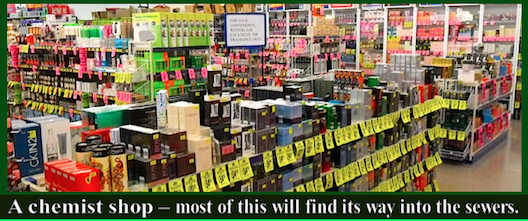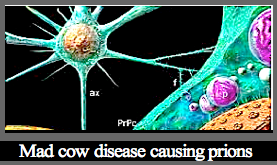You are here: Home1 / Do Australian Cities Have The Wrong Approach To Recycling Water?


Primary Water (1), (2),
Secondary Water = rain, hail and snow
and Recycled Water.
—–<◊>—–
Most cities OUTSIDE Australia have separate:
1) ‘Black Water’ which contains sewerage,
2) ‘Grey Water’ from baths, sinks and showers ect. *
3) ‘Storm Water’ from roofs of buildings.
4) ‘Spring Water’ from under ground (which can be ‘Primary Water’)
However most cities in Australia do NOT have separate
‘Grey Water’ because it shares the same system as ‘Black Water’.
→ This is an unfortunate historic error as ‘Black Water’ is
NOT recyclable because it contains sewerage,
hospital waste, drugs, low level nuclear waste,
and lithium, which can only be removed
by steam distillation.
As can be seen from the above “purified recycled water”
is dangerous wishful thinking by the Queensland Gov.
* [ “Fifty shades of grey” ! ]

A visit to the local ‘Chemist Warehouse’ is an insight to what is in
‘Black Water’ plus hospital and industrial waste.
Queensland Urban Utilities Please Note:
The separation of lithium from waste water is VERY expensive.
The only mechanism that can separate lithium from water to make
it potable is distillation.
Queensland Gov, we are sorry to rain on your parade, but many
nations have investigated and abandoned the idea of recycling water.
–—-<◊>—-–


Mad Cow Disease – causing prions, can survive conventional sewage treatment…
Prions — rogue misfolded proteins that cause mad cow disease, chronic wasting disease, and its human equivalent, variant Creutzfeldt- Jakob Disease — are not degraded by standard wastewater decontamination. Prions are notoriously resilient to extreme heat, caustic chemicals and irradiation.
– Bovine spongiform encephalopathy (BSE), commonly known as mad cow disease, is a fatal neurodegenerative disease (encephalopathy) in cattle that causes a spongy degeneration of the brain and spinal cord. BSE has a long incubation period, about 2.5 to 8 years, usually affecting adult cattle at a peak age onset of four to five years, all breeds being equally susceptible. BSE is caused by a misfolded protein—a prion. In the United Kingdom, the country worst affected by an epidemic in 1986-98, more than 180,000 cattle were infected and 4.4 million slaughtered during the eradication program.
While prions aren’t technically viruses, they act like them. And even worse, prions are known to survive chemicals, heat, and other forms of sterilization that would otherwise kill normal pathogens – which makes prions perhaps the most serious problem associated with bio-sludge and sewerage recycling.
[ Many Australians were in the UK during the ‘Mad Cow’ epidemic! ]
———◊———
…Might Alzheimer’s Disease be “Foodborne” ? (Extract from Mercola.com)… Symptoms of vCJD are similar to Alzheimer’s and include staggering, memory loss, impaired vision, and dementia and there’s no known cure. An intriguing suggestion is that Alzheimer’s is a slower moving version of Mad Cow disease, acquired by eating contaminated CAFO meats… TDP-43 might also “predispose” you to Parkinson’s, or Lou Gehrig’s, just as easily as alzheimer’s which disease ends up materialising may depend on the area of your brain the proteins attack.
————◊————
Images of over six devises.
—————◊—————
More on



Down the drain:
Do Australian Cities Have The Wrong Approach To Storm Water?
Full Original Text → HERE
Only a 4 min. read
An inventor from Western Australia is on a mission to change the fate of urban stormwater with an at-source solution that helps transform the contaminated wastewater into a valuable resource.
The founder of Urban Stormwater Technologies Craig Rothleitner knew nothing about stormwater when he set out to solve a problem he noticed while working on dredging projects like the Sydney Harbour Tunnel. – All he knew was what he saw.
“We were dredging the bottom of harbours to deepen them and there would be all this black ooze that we would put onto barges and dump out to sea,” he said.
This ooze was made up of the rubbish and rotting vegetation that collects in stormwater drains before being flushed out into waterways. The vegetation is particularly problematic as it begins to breakdown when moisture is present in a drain and releases nutrients that can be harmful to ecosystems.
“Stormwater infrastructure has been designed to prevent flooding with little or no regard for waterway contamination,” Rothleitner said.
“The drains are the first collection point for vegetation, cigarette butts, plastics, sediment, sand, building waste – everything that can go in the drains, will.”
Down the drain-
There is no clear record of how much stormwater flows through Australian drains each year, but it has been estimated the country’s urban areas produce about 3000 GL of runoff annually. Less than 3% of this rainwater and stormwater is re-used.
Meanwhile, Australian cities draw an estimated 2100 GL of water from their catchments and groundwater sources annually.
In an era when governments around the world are attempting to climate-proof their water sources, Rothleitner said he believes stormwater should be recycled for use in water sensitive urban design (WSUD) projects or used to replenish groundwater supplies.
While there are notable examples of stormwater re-use in Australia – for example, South Australia’s successful use of managed aquifer recharge – he said this should be a matter of course rather than the exception.
“The most important thing we’re trying to get across is that stormwater is a valuable and substantial resource,” Rothleitner said.
“Currently stormwater is considered a contaminated wastewater, but it’s not contaminated when it comes out of the sky. It becomes contaminated when it lands on urban areas.”
Out of sight, out of mind
Rothleitner said one of the reasons stormwater has been ignored is the majority of the infrastructure is “out of sight, out of mind”.
“There is a public disconnect between the water that falls on our heads and on the roads, and what happens to this water and waste next,” he said.
“People think it goes down the drain and that’s it. That’s the last time they think about it.”
He said the lack of an at-source treatment capable of handling the sheer amount of water and waste that enters each drain has also prevented re-use, as it means water becomes contaminated the second it goes into a drain.
The problem is compounded by the fact that local councils generally take a reactive approach to managing stormwater infrastructure, unlike sewers or roads which they tend to actively maintain.
This means they remove tree roots and address waste when it builds up, but don’t proactively protect the drains.
“The tree roots we can’t do anything about, but the waste entering the drains we can,” Rothleitner said.
“Things like sediment and sand wear concrete stormwater pipes down, while the rotting vegetation becomes acidic and starts chewing them out at the same time … The day you stop waste going in is the day the infrastructure is protected.”
A catch-all solution?
Rothleitner spent more than 10 years developing a solution to the problem. He designed a catch basin insert made of a material that can filter particulate-rich water down to 63 micron – about one tenth the size of a grain of sand – at over 30 litres per second.
As his vision is to see councils across the country use the technology, Rothleitner knew he had to prove the science behind it.
He spent four years working with civil engineers from Curtin University to test the effectiveness of the insert. Their research, which was published recently in the Journal of Environmental Management, found the inserts now increased the overall quality of water entering the system by up to 80%.
With WA alone featuring more than a million drains, Rothleitner said it would be impossible to put one of his devices in each of them. Instead, he said the catch basin inserts should be used in conjunction with end-of-line treatments.
“It’s basic common sense. If you protect the system from the beginning, what happens at the end has got to be better than if you let all the rubbish go in it,” he said.
“But we don’t have a single solution – we’re here to work with everybody. Stormwater is too much of a resource to lose.”
Share
Previous PostPrize-winning device creates drinking water from thin air
Like “a pressure cooker for sludge” – The case for thermal hydrolysis
Scroll to top
Leave a Reply
Want to join the discussion?Feel free to contribute!